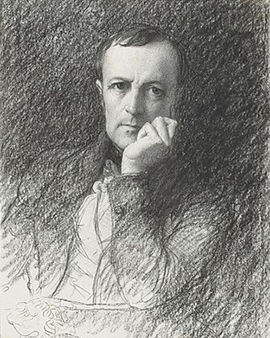A dazzling personality of the art world, who left his mark on academic realism, is the French history painter Paul Delaroche, whose works take us on a journey through time. In the heart of Paris, on July 17, 1797, Delaroche opened his eyes to the world before finally bidding farewell to it on November 4, 1856. In the annals of art, he is also known as Hippolyte Delaroche, a rare name that does justice to his complexity and uniqueness. Delaroche, affectionately known in the family as "Paul," was the second son of Grégoire-Hippolyte de la Roche and Marie-Catherine Bégat, a family deeply rooted in the Paris art scene for generations. They lived in a house on Rue de la Vrillière in the 1st arrondissement, a street that was considered the epicenter of the art scene. Delaroche began his training in painting in 1816 at Louis Etienne Watelet before moving to Antoine Jean Gros's studio two years later. Gros, a renowned artist of his time, was instrumental in shaping Delaroche's style and expression. His talent was quickly recognized and in 1822 he made his debut at the Salon de Paris. Here he met Theodore Gericault and Eugène Delacroix, two other emerging painters of his time, and together they formed the heart of Parisian history painting.
Delaroche's work exuded a fascinating blend of classicism and romanticism, a style that made him distinctive on the art scene. His paintings, carefully staged and executed down to the smallest detail, mostly depicted dramatic historical events that emotionally captured the viewer. Delaroche drew inspiration from the social and political turmoil of his time and wove these themes into his art, often depicting high nobles at crucial moments. These motifs were considered emblematic of the political uncertainty of the day and resonated with his audience. Delaroche's artwork left a lasting impression of rare intensity and deep feeling.
Among Delaroche's masterpieces, Execution of Jane Grey stands out, a powerful, ahistorical portrait that took place outdoors. With each brushstroke, Delaroche painted a story that extended beyond the frame of the painting and captured the emotions of the viewer. He also referenced contemporary developments in photography, recognizing that the daguerreotype, an early form of photography, had the potential to revolutionize painting. Today, we honor Paul Delaroche as one of the most important history painters of his time and value his art as an irreplaceable contribution to our cultural heritage. Our company is proud to keep his works alive through high quality art prints that do justice to the finest nuances of his art. Each art print is a tribute to Delaroche's masterful skill and his extraordinary ability to convey the complexity of history through the language of art. We invite you to embark on a journey of discovery and explore the fascinating world of Paul Delaroche through our exquisite art prints.
×





.jpg)
.jpg)
.jpg)
.jpg)
.jpg)
.jpg)
.jpg)
.jpg)
.jpg)
.jpg)
.jpg)
.jpg)
.jpg)
.jpg)
.jpg)
.jpg)
.jpg)
.jpg)
.jpg)
.jpg)
.jpg)
.jpg)
.jpg)
.jpg)
.jpg)
.jpg)
.jpg)
.jpg)
.jpg)
.jpg)
.jpg)
.jpg)
.jpg)
.jpg)
.jpg)
.jpg)
.jpg)
.jpg)
.jpg)
.jpg)
.jpg)
.jpg)
.jpg)
.jpg)
.jpg)
.jpg)
.jpg)
.jpg)
.jpg)
.jpg)
.jpg)
.jpg)
.jpg)
.jpg)
.jpg)
.jpg)
.jpg)
.jpg)
.jpg)
.jpg)
.jpg)
.jpg)
.jpg)
.jpg)
.jpg)
.jpg)
.jpg)
.jpg)
.jpg)
.jpg)
.jpg)
.jpg)
.jpg)
.jpg)
.jpg)
.jpg)
.jpg)
.jpg)
.jpg)
.jpg)
.jpg)
.jpg)
.jpg)
.jpg)
.jpg)
.jpg)
.jpg)
.jpg)
.jpg)
.jpg)
.jpg)
.jpg)






